Richard Demarco
About Andrew Cusack
 Writer, web designer, etc.; born in New York; educated in Argentina, Scotland, and South Africa; now based in London.
Writer, web designer, etc.; born in New York; educated in Argentina, Scotland, and South Africa; now based in London. read more
News
Blogs
Reviews & Periodicals
Arts & Design
World
France
Mitteleuropa
Knickerbockers
Argentina
The Levant
Africa
Cape of Good Hope
Netherlands
Scandinavia
Québec
India
Muscovy
Germany
Academica
Richard Demarco
“We didn’t know quite how to take this, but we sat there entranced.”
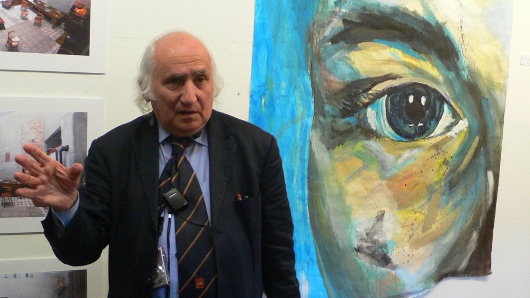
ONE OF THE markedly few deficiencies of the English language is coming up with a word to describe Richard Demarco. The Scottish press have generally settled upon “impresario” but even that somewhat-ambiguous word fails to do the man justice. Ricky was born in Edinburgh in 1930, grew up in Portobello, and remembers the day when his mother held him back from school because Italy — from whence he stock came — had just declared war on Great Britain. He’s attended every Edinburgh Festival since the very first one began in 1947 — as the founders put it, to “provide a platform for the flowering of the human spirit” in the grim aftermath of the Second World War.
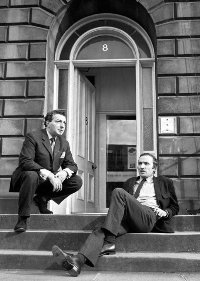 Richard Demarco, couchant, with noted Scots caricaturist Emilio Coia.
Richard Demarco, couchant, with noted Scots caricaturist Emilio Coia.In 1963, he cofounded the Traverse Theatre, Scotland’s theatre for new writing, and three years after that founded the Richard Demarco Gallery which promoted Scotland’s cultural interchange with artists across Europe including — very importantly to Richard — from behind the Iron Curtain that divided the continent into free and captive halves. This was during an age when many in the arts world were too busy sympathizing with the murderous totalitarianism that had subjugated half of Europe. Richard has been a deep critic of the choices made by the British government as patron of the arts throughout the decades of his life, but not too long ago he finally patched things up with the Scottish Arts Council.
Readers of Alexander McCall Smith’s 44 Scotland Street might recall the man who comes to speak to the Scottish Police College. The “really important person from the art world in Edinburgh”, as Mr. McCall Smith puts it, comes and tells the trainee constables about the gorgeousness of Italian carabinieri uniforms and how the Scottish psyche still suffers from the iconoclasm of the Reformation, and even suggests architectural alterations and more sympathetic decoration of the Police College. “We didn’t know quite how to take this, but we sat there entranced,” the character admits in 44 Scotland Street. Anyone who either knows Ricky or has been to one of his lectures would immediately recognize the unnamed subject of the passage.
I first met the man when I was a first-year student at St Andrews and he had come up from the capital to give a lecture. I can’t remember what the stated subject was but this is entirely irrelevant as so vast and wide-ranging is the mind & experience of Richard Demarco that he is known for (some would say “notorious for”) never keeping within the bounds of the stated subject. Those who invite Richard to speak shouldn’t bother with a subject, just make posters stating “RICHARD DEMARCO SPEAKS”, giving the date, time, and place, and a crowd of interested characters is bound to turn up. (more…)
Plumbing Cusackian Depths?
Robert Harrington recently insisted on interviewing me, taking many of his questions from a previous interview years ago which had been available at andrewcusack.com but which has since inexplicably disappeared into the ether. (Such are the mysterious ways of the internet). Mr. Harrington unconvincingly insists that the previous interview provided an interesting insight into the mind of Cusack, and no doubt he hoped to gain further useless insights with this period of interrogation. We will leave it to the reader to judge. What follows is an only barely edited version.
You’re known as an architecture fan. What’s your favourite city?
Edinburgh. Finest city in the British Empire.
Finer than London?
Oh, I’d say so. London has a great deal going for it — better clubs, for example — but it’s become incredibly vulgar. And foreign. Edinburgh is ten times as beautiful. What is more beautiful than an Edinburgh sunset, with the waning light reflecting off the stone buildings and the various spires and towers? The topography of the city is its saving grace, but can also be an incredible hassle. If you want to walk along George Street or Princes Street or the Royal Mile, you’re fine. But any perpindicular perambulation becomes a matter of climbing hills and stairs and such. Yet it makes the city all the more worthwhile somehow. It’s very striking.
Your favourite building though, the old Irish Parliament (now the Bank of Ireland) is in Dublin.
Dublin also has a great number of brilliant edifices, great buildings. Not just the Bank of Ireland but Trinity College, the Castle, the Four Courts, the Custom House, the King’s Inns and Henrietta Street and all those Georgian buildings. And two medieval cathedrals! But no, Edinburgh is still finer, and unsullied by republicanism.
But the ugly Scottish Parliament building is in Edinburgh.
True, true. A recent goiter upon an old friend though. Surgery can remove such things, if the patient is willing and a surgeon can be found.
The Auld Scotsman
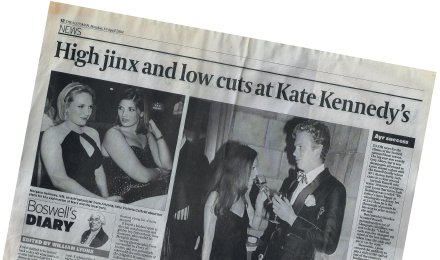
ONE THING WE greatly enjoyed about the Scotsman in its pre-tabloid days was that they often deemed St Andrews social events worthy of coverage in their august pages. It was a source of pride to see ‘the national newspaper’, a respectable broadsheet, covering events at the oldest university in the land (which we are proud to call our own). Naturally, once the conversion to tabloid size was complete, we were rarely heard of again, which was a little saddening. The Scotsman is not what it used to be —a beautiful, well-designed, informative respectable newspaper— but it still manages to print some thoroughly worthwhile articles which is more than can be said of any other Scottish daily. (One need only point out two articles by Prof. Haldane, c.f. here and here, recently posted on this site).
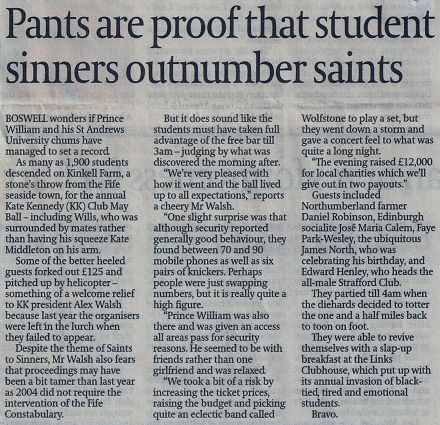
“…when the diehards decided to totter the one and a half miles back to toon on foot.” Sounds familiar.
Admittedly, most of the events covered were organised by the Kate Kennedy Club, which seems to take pride in the sheer vulgarity and tastelessness with which they advertise many of their events. (This is only slightly mitigated by their superb running of the annual Kate Kennedy Procession). Still, we enjoyed the Scotsman‘s coverage and wish it had continued. I only bought the Scotsman on occasion after the switch, but often gave the Common Room’s copy a browse when I lived in St. Salvator’s. (Its Sunday edition, Scotland on Sunday is worth buying for Gerald Warner alone).
Here are a few bits and pieces clipped from the Scotsman for your perusal:
‘Undampened spirits take the party indoors‘ / Lumsden Club garden party moved indoors on account of the rain. (I didn’t go).
‘High jinks and low cuts at Kate Kennedy’s‘ / This covered the Kate Kennedy Procession dinner which takes place at the Old Course Hotel on the evening following the procession. This particular year I was in attendance myself and recall commiserating with Michelle Romero, that charming daughter of Venezuela, about the troubled state of her native land. I was their with our favorite Dane, Sofie von Hauch, and my flatmate, a member of the KK who wishes to remain unnamed on this site. Will Lyons couldn’t make the dinner himself, so he sent ‘K‘ up instead, accompanied by ‘society photographer Z‘ whom I ran into while we were on our way out.
‘Maltesers set ball rolling for charity‘ / The 2004 Knights of Malta Ball, not covered by this website because it did not exist at the time. It was a good time, especially so because I had three friends over from the States. Yalie Adam Brenner was doing his semester abroad at St Andrews at the time, and fellow Old Thorntonian Clara de Soto popped over from Boston College for the weekend with her good friend Katie Cordtz of Atlanta. The four of us together with Michelle Romero and the aforementioned unnamed flatmate of mine piled into a cab and made the hour’s journey to Edinburgh for the soirée. Poor Adam, though. Towards the latter part of the evening Archie Crichton-Stuart, an exceptionally amusing Edinburgh student, and his friend Ramsay forced Adam to consume the significant remnants of a bottle of house red. It all went down swimmingly, but came back up on the cab ride back to Fife. Freddy McNair, who was recently nearly killed by an incompetent gurkha on a training ground, sat at the table next to ours, I recall. (Also, in the lower right-hand corner of the clipping you can spy the face of our good friend Ricky Demarco peering out from an unrelated article).
Previously: Another Broadsheet Bites the Dust
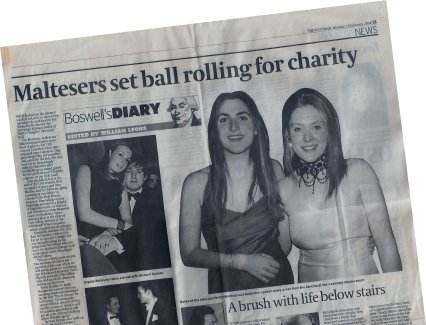
The Knights of Malta Ball 2006

BACK DOWN TO the Assembly Rooms of Edinburgh for the annual ritual of the Knights of Malta Ball and I am happy to report that, as per usual, a good time was had by all. We had a larger contingent heading down from the Auld Grey Toon than last year (when it was just Fräulein Hesser and myself), consisting of Abigail, Jon Burke, Stefano, Clare Dempsey, and yours truly. After gliding down from Fife via taxicab, we met up with Zygmunt Sikorski-Mazur, Jamie Bogle (sans Joanna, alas), and Gerald Warner at the Opal Lounge, a little past half six, and managed to pack in at least a round of drinks before heading across George Street to the Assembly Rooms (depicted in the engraving below).

Having dropped off our coats and such, we swept up the staircase to the Ballroom for some champagne before dinner. After mulling about and conversing for a while we bumped into the Cardinal Archbishop of St Andrews himself, H.E. Keith Patrick O’Brien, himself a Grand Cross Conventual Chaplain to the Order of Malta. We apologised for not maintaining his senior cathedral in St Andrews in the same state as his junior one in Edinburgh, but I did thank him profusely for allowing us an indult mass at Ravelston. (more…)
Leisure
I AM BACK HOME in New York after having completed my Martinmas term examinations. This morning, my mother, sister, brother-in-law, and I went out for breakfast to celebrate my “triumphant return from another term at university.” (I suggested it might be wiser to wait until the casualty reports are released before we declare it a triumph).
Nonetheless, I now have three weeks of time almost entirely free from obligations to do whatever I please. It is perhaps how a man spends his free time that defines him, as free time is the foundation of civilization itself. Roger Kimball reflects on this in a recent Armavirumque posting, mentioning Josef Pieper and Leisure: The Basis of Culture, a book I was first introduced to by Robert O’Brien whilst still half-asleep at 7:30 in the morning waiting for a train at Leuchars station so we could attend the Tridentine mass in Edinburgh.
Leisure, by which we mean doing something merely for its own sake, is entirely different from mere pleasure. Unfortunately for the English language, we oft mistake the two for synonyms. It is leisure in that latter sense, of idleness and cheap pleasure, which our good friend Prof. Richard Demarco resoundly condemned in a lecture he gave at St Andrews. This kind of leisure, he stated, was leading to the destruction of Scotland, of Europe, and of civilization. Art today, according to Richard, is a collection of usually talentless kitsch which seeks merely to create an arrangement that is pleasing or clever. Art, in Richard Demarco’s world, should not aim to be pleasing, or to be clever, but should have as its essence the very highest that man can achieve: the sanctification of souls. In pursuit of pleasure rather than leisure, tourism is taking over entire countries; a false economy which can enslave the entire population of a given area.
It is certainly rampant in St Andrews. There are many good reasons to visit St Andrews. The third-oldest university in the English-speaking world, for example, or perhaps to see ruins of one of the greatest shrines in Christendom, bearing witness to the visceral damage wrought by the Protestant Revolution (we should refuse to dignify that revulsion with the name of ‘reformation’; it destroyed and replaced, not reformed). Most, however, come for the golf.
While niches once full remain empty from the holocausts of five centuries ago, the Scottish Parliament would prefer to spend its millions (which, you must never forget, are the people’s millions) on encouraging this pointless and ineffective idleness, Demarco pointed out. More recently, South Street, where I live, will soon be shorn of its beautiful trees, those which make it one of the most inviting and comely thoroughfares in the Royal Burgh. This must be done, we are told, to increase the number of parking spaces, the paucity of which might be driving away potential tourists. Perish the thought! Heaven forbid a town be run for the benefit of its inhabitants, for the benefit of itself (but surely by now they have already forbidden Heaven).
As Mr. Kimball points out, the opposite of the former leisure, the leisure which Pieper posits is the basis of culture, is busyness. Perhaps we can extend this to business, for it is the dollar, the pound, and the euro which enslave St Andrews to transient tourists. Without tourism, some say, St Andrews, or Oxford or Venice or wherever, would not survive. But at what price survival? And who defines this survival? That these places are still on the map and are inhabited is for sure. But in some sense have not these places, while encouraging tourism as a mode of survival, been so changed and transformed that in fact they have not survived. Decrepit and rundown, they may have been, but at least they had authenticity; at least they were themselves. Now most of the goods sold in St Andrews – saltires, fake kilts, tam o’shanters, and Scotland t-shirts – are in fact things that can be purchased in half the towns in Scotland, and now with the advent of the internet, you can purchase them while you remain at home. Their cheapness is only accompanied by the sentiment of being a souvenir in the original French sense of the word: to remember. But they are remembrances for short memories, and likely will be thrown out within a year, because we, and it all comes back to this, do not have the time for longer memories.
Thus one of the chief values of an education must be free time. St Andrews affords this, I am glad to say; especially if you are an arts student and are not aiming for a first. All too often friends of mine at universities in the States or at Oxbridge are busy. They are either busy with busywork, (assignments for school which must be done to stay in the university but have little graded value or academic merit) or else busy with social activity and other amusements which vary greatly as to whether one’s in a big city or not (most often the case with NYU students I find).
When I finally start my university, we must make sure that students have enough free time then, perhaps the greatest argument for not locating it in an overactive urban metropolis. Though of course a good part of education is that which transmits information and ideas and, more importantly, inculcates moral values, much must be left up to the student. There is an inherent value in reading not what is required but what is desired.
And so I will get on with my post-exam break, reading the Pickwick Papers, the Everlasting Man, and This Side of Paradise, hopefully with some time to browse through Haldane’s Faithful Reason: Essays Catholic and philosophical (which, on a typographical note, makes ample use of the Gill Sans font).
Pining for Andreanopolis
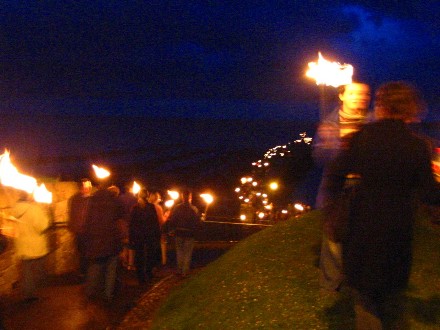
Photo: Peter Tweed
Just over a fortnight to go, but a number of things I miss about St Andrews:
The people (too many to mention), wearing academic gowns, torchlit processions, dinner parties, St. Salvator’s Chapel, three-piece suits at Chapel, lady preachers making fools of themselves at Chapel, the after-Chapel bit of sherry, tweed, the Kensington Club, tweed, the ruins of the Cathedral, tweed, the Pier, the East Sands, the West Sands, Castle Sands, the Castle, the Castle Tavern, the Central, Broon’s, Ma Bell’s, not so much the Westport but their beer garden instead, eating at the Golf Hotel, reading the magazines in the common room of Canmore, reading everything else in the library of Canmore, big dinner thursdays, avoiding the Students Union at all costs, Queens Gardens, the Quarto, the Bouquiniste, chips, the late movie on Wednesday nights, anything and everything Richard Demarco is involved in, plotting reaction, writing the Mitre, reading the Mitre, reactions to the Mitre, St. Leonard’s Chapel, candlelit compline, the Scores, Boots’ meal deal, the evangelists in the streets, Parliament Hall, St. Mary’s Quad, St. Katharine’s Lodge, St. John’s House, the King James Library, the Bunk Room in St. Mary’s, Professor Haldane’s house, the hallway chat after the daily Rosary, the Parish garden, Fr. Halloran’s black vestments and the fact that he still uses them, the Latin Mass in Edinburgh and everything that goes with it, the Telegraph, the Spectator, making fun of people, being made fun of, evensong at Holy Trinity, the Renaissance Group, St. Salvator’s Hall, Hamilton Hall, University Hall, Lower College Hall, the Old Union Diner, Butts Wynd, St. Salvator’s Quad, North Street, Market Street, South Street, the Pends, the Cemetary, the cloister, the chapter house, driving up and down the Fife coast, awkward people, the Whiskey-tasting Society (oh boy!), unapologetic support for the monarchy, international diplomacy, an appreciation for Chesterton, representing New York abroad, beautiful and charming South African tutors, Dean’s Court, champagne, the Royal & Ancient, innocent decadence, Kinburn Park and the lawn bowling club, Bishop Kennedy’s tomb, the Buchanan, falling asleep in lectures, doing the crossword in lectures, inscribing the Sacred Heart of Jesus, monarchist slogans, or anachronistic pro-Rhodesian graffiti onto lecture hall desktops, tea after Mass, Country Life, the Kate Kennedy Procession, buying the papers at J+G Innes, formal events, wearing the old school tie, the Annual Boules Match in St. Mary’s College, the Younger Hall, plotting to start a croquet club, people willing to sacrifice their lives for their country, my complete inability to write an essay without Jameson’s, paninis from Cherries, Luvian’s wine shop, all the alleyways, the Byre Theatre, the bar at the Byre, Pimm’s on the lawn, Christianity being taken seriously, incessantly amusing people, life in St Andrews. Life in St Andrews!
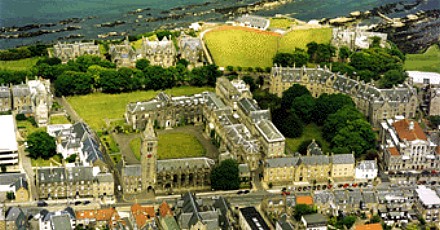
Search
Instagram: @andcusack
Click here for my Instagram photos.Most Recent Posts
- Burns Tower April 19, 2024
- Patrick in Parliament March 18, 2024
- Articles of Note: 13 March 2024 March 13, 2024
- Cambridge March 9, 2024
- Taken on Trust March 4, 2024
Most Recent Comments
Book Wishlist
Monthly Archives
Categories


